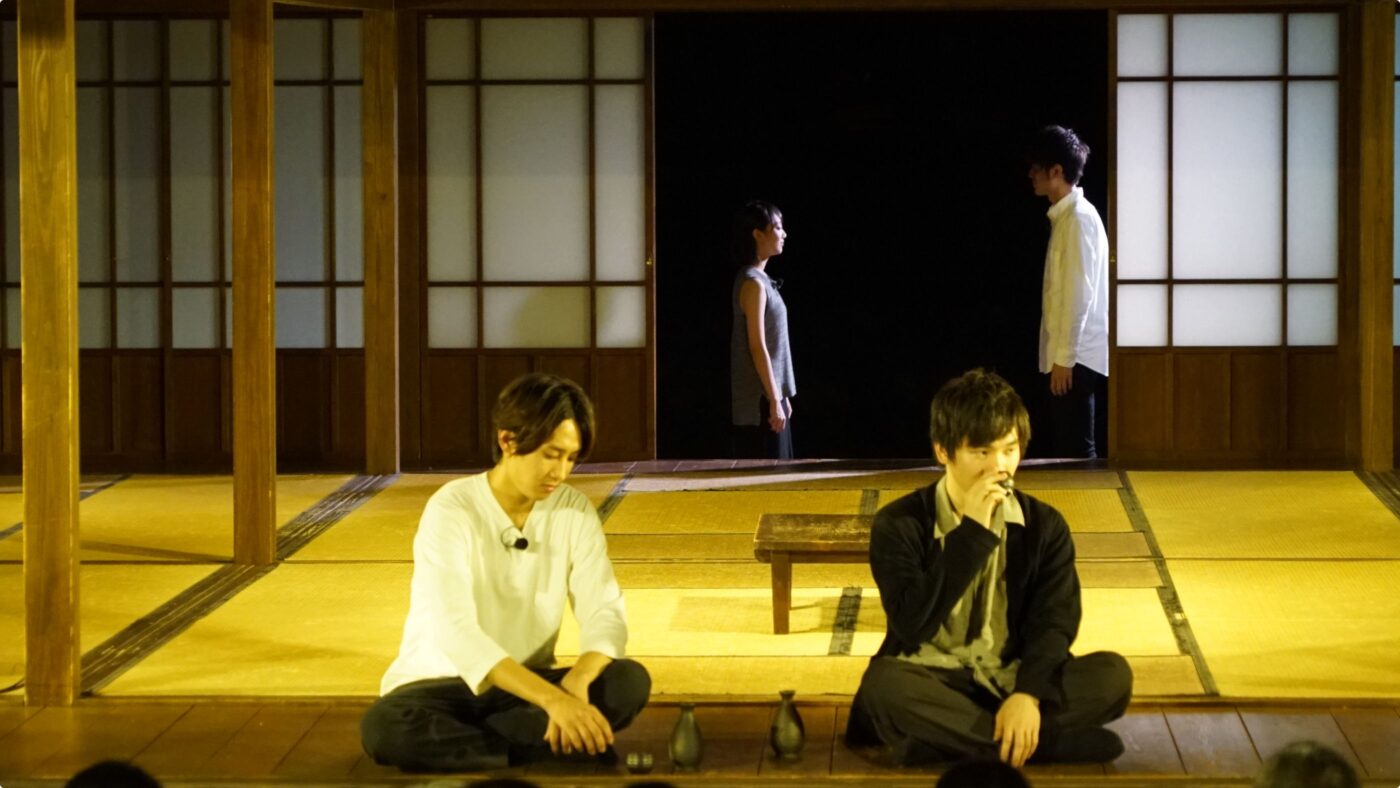Interview:
Inside Japan Selection
Theatre Company Awai — SONNET

Translating a Translated Work into Theatre

Since its founding, Awai has created contemporary theatre grounded in Japanese traditional culture while drawing on global artistic and philosophical traditions. Their 2019 production SONNET is not based on one of Shakespeare’s plays, but on his poetry collection SHAKE-SPEARES SONNETS. The performance adapts the Japanese translation by Kenichi Yoshida, known for his bold interpretative style.
Shakespeare’s Sonnets depict a long-spanning emotional journey of two men and one woman over the course of 14 poetic scenes. In Awai’s version, the setting shifts to Japan, and the piece incorporates the narrative of Yoshida’s essay “Umibōzu.” In one room, a man shares drinks with a friend. In another time, he appears with a woman. In yet another, he is again with the friend. The lines between memory and encounter, the living and the spectral, blur as time and space fold into one another. Through this storytelling, the language of Shakespeare intertwines with that of Yoshida.
Awai chose Yoshida’s translation for its uniqueness. Yoshida saw translation as a form of critique. His version of the sonnets does not follow the original sequence; it rearranges and abbreviates them based on his interpretations. As a result, time and human emotion feel more immediate and tangible. Unlike many translators who treat ageing as a tragedy, Yoshida frames it as a natural passage of time. He also posits that the moment one recalls a memory is itself the present. This reimagining of time and atmosphere resonated with the company, leading to their selection of his text.
Takamoto, a company member and producer, explains: “We chose the Yoshida translation as a group. His take on Sonnet seemed to gently accept contradictions—like wanting to love but being unable to, or the anxiety of ageing. In the performance, we deliberately express multiple memories surfacing. By rendering time seamlessly, both past and present become simultaneous ‘nows.'”
This production seeks to translate the literary and philosophical qualities of Yoshida and Shakespeare into theatre as a time-based spatial art. It attempts to stage the spatial quality of poetry, then further translate it into a theatrical space.
The structure reflects this intent. The 14 scenes follow the pattern of a Shakespearean sonnet (ABAB CDCD EFEF GG), each scene opening with an original piece of music based on corresponding chord progressions. Drawing on Yoshida’s critiques, the production speculates when Shakespeare wrote each section of the Sonnets, linking those parts to his plays written during those periods—from Romeo and Juliet to The Tempest—which are quoted within the scenes. This alignment of scenes and music allows audiences to physically experience the rhythm of Shakespeare’s verse.
This artistic choice also informed the performance environment. The premiere was staged as an intimate conversation in a traditional Japanese house. Later, a jazz bar version with live performance followed. Both formats allowed audiences to relax, drink, and immerse themselves in the ambience. Future stagings will continue to adapt to each venue, creating environments where audiences can surrender to the performance.
Ultimately, Sonnet aims to raise Yoshida’s poetic space directly onto the stage, translating not just the text, but also the literary sensibility of Yoshida and Shakespeare into a theatrical experience.
“The experience may be closest to the narrative form of Noh, a traditional Japanese theatre style. Through the performance, the audience encounters the protagonist’s memories and past, touches the words of Shakespeare and Yoshida, and is invited to reflect on their own past and memories. Our hope is that many ‘present moments’ will be born in the theatre” (Takamoto).
For international English performances, the company does not simply revert to Shakespeare’s English. Rather, they aim to re-translate the sonnets into English, incorporating the uniquely Japanese sense of time and philosophical framing embedded in Yoshida’s translation.
Seeing into the 'In-Between': Country, Culture, Time, Genre

Awai was founded in 2018 while all members were university students. In 2019, they won a national Grand Prix while still studying, drawing attention. Since then, they’ve received multiple theatre awards and performed at festivals across Japan. Playwright-director Kentaro Otsuka fuses diverse genres: Noh and rakugo (Japanese traditional arts), Shakespeare and other global literary classics, alongside manga and pop music. His works continually reinterpret these sources as avant-garde expressions within a modern context.
Their 2019 piece Drifting drew on Japanese historical content like Noh while incorporating futuristic elements such as Astro Boy. Traversing past and future, the piece blended imagery and periods while evoking a uniquely Japanese sense of time.
Sonnet, also premiered in 2019, became the group’s foundational work—centred on translation and the seamless portrayal of memory and time. By staging the work outside traditional theatres, they adopted a new creative approach: embedding the qualities of a venue into their dramaturgy. Since then, their pieces intentionally manipulate perceptions of time and craft experiences that resonate uniquely with each location. The company even contributed to a publication on Yoshida’s translations, gaining academic recognition for their interpretive work.
In 2022, they staged Corona, a requiem juxtaposing the COVID-19 pandemic with solar coronas observable during eclipses. This was a re-creation of their earlier work Letter, which fused Western poetic traditions—from Edgar Allan Poe to Paul Celan—with Japan’s millennial “sekai-kei” otaku narratives. After its Tokyo premiere, it toured with altered staging. In April 2023, a solar eclipse viewed in Australia was live-streamed and incorporated into a performance marking the pandemic’s symbolic end.
The company’s name, Awai (an archaic reading of “aida,” meaning “space between”), reflects a desire to explore the interstices between past and present, self and other, art and entertainment—not to fixate on binaries, but to generate new relationships and values from the in-between.
Creating site-specific works for local audiences

Given this philosophy, Awai adapts its works for international performances through retranslation and re-staging, engaging the specific cultural and spatial contexts of each location. Their goal is to fuse Japanese temporality with local audience sensibilities through theatre.
“We aim to create experiences that transcend boundaries—of space, music, and image. Theatre and art have the power to synthesise disparate times and cultures, opening new possibilities. We believe such works can provide new perspectives to international audiences and, in turn, bring us new insights. We hope theatre becomes a gateway to cross-cultural dialogue” (Takamoto).
Awai is also eager to pursue on-site and collaborative creation abroad. “We want to make works where previously unconnected cultures don’t clash—but co-exist.”
They see difference—in language, culture, perception—not as a barrier but as a theatrical device in itself. They hope to absorb audience reactions and create regionally rooted performances that reflect each location’s unique dialogue between performers and viewers. With local producers and coordinators, they aspire to generate cultural fusions that could only arise in those specific places.
Original Text by Momoko Kawano
Translated by SOIL Team
